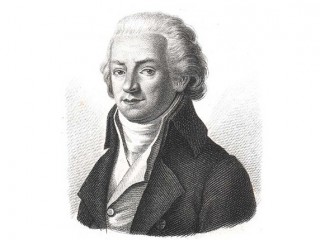
Samuel Thomas Von Sömmerring biography
Date of birth : 1755-01-28
Date of death : 1830-03-02
Birthplace : Thorn (Toruń), Prussia
Nationality : German
Category : Science and Technology
Last modified : 2010-06-09
Credited as : Physician and anatomist, discovered the macula in the retina of the human eye,
0 votes so far
Samuel Thomas von Soemmering was an outstanding physician with various interests in the areas of physics and communication engineering. He developed an electrochemical telegraph where the signal was transduced electrochemically as bubbles originating from electrochemical water decomposition. Samuel Thomas von Soemmering was born as the ninth child of the doctor Johann Thomas Soemmering and the minister’s daughter Regine Geret.
He finished Thorner secondary school, and then, in 1774, continued his education at the Department of Medicine of the University of Gottingen. He was a pupil of many famous medical scientists such as Ernst Gottfried Baldinger (1738-1804), Heinrich August Wrisberg (1739-1808) and Johanns Frederick Blumenbach (1752-1840). Thomas Soemmering recieved his degree in medicine in 1778 and after that he went on a study trip to the Netherlands, England and Scotland.
During this trip he met famous anatomists Pieter Camper (1722-1789), John Hunter (1728-1793) and Alexanders Monro (1733-1817). In 1779 Soemmering became Professor of the Anatomy in the Kasseler Collegium Carolinum. He became acquainted with Johann Wolfgang von Goethe (1749-1832) and they maintained this contact about a decade. In 1784 Soemmering was appointed as a Professor of Anatomy and Physiology at the University of Mainz, where five years later he became a dean of the Medical Faculty. In 1792 he married Margarethe Elisabeth Grunelius (1768-1802); from the marriage they got a son Dietmar Wilhelm (1793-1871) and a daughter Susanne Katharina (1796-1867).
In 1797 Thomas Soemmering for political reasons left Mainz and became a practical doctor in Frankfurt-on-Main. In 1800, during his medical practice in Frankfurt, Soemmering introduced smallpox protective inoculation. In 1802 Soemmering got two offers from the universities of Jena and St. Petersburg that he however rejected in favour of the third offer from the Munich Academy of the Sciences. In 1805 he was appointed as a member of the Kurfurstlichen Pfalz-Bayerischen Hofrat (Bavarian Academy of Science). Because the promised equipment for the anatomy building was delayed and failed, finally, Thomas Soemmering shifted his work more and more to the areas of physics and the paleontology.
Thomas Soemmering collected many facts important for medicine and anatomy. He illustrated his anatomical and scientific publications with impressive pictures fascinating by exactness and beauty. All his works about the nervous system and the sense organs were well recognized by colleagues. His thesis about comparative anatomy of the brain that was published in 1778 provided him rapidly increasing good reputation in the scientific world.
His conclusions about the brain basis and the origin of the brain nerves are valid till now. Soemmering did not consider the spinal cord as a big nerve, but rather as a part of the central nervous system. He designated the pituitary gland as a “hypophysis” and he discovered in 1791 the yellow spot in a retina of an eye. His book “About the Organ of the Souls” in which he placed “soul” in brain resulted in many discussions from the year 1796. Soemmering left many publications in the areas of the general medicine, anatomy, neuro-anatomy, anthropology, paleontology, physics, philosophy and astronomy.
Thomas Soemmering was always interested in electrical phenomena, particularly those that are related to the biological and medical sciences. Soemmering started his experiments with electrical machines during his stay in London and he had numerous discussions about electricity with Georg Christoph Lichtenberg (1742-1799) and Alexanders von Humboldt (1769-1859). Particularly, Soemmering was working with galvanic cells and this work brought him to the development of the electrochemical telegraph.
In 1809 Samuel Soemmering developed the first telegraph in Bavaria. He used a device with 26 wires (1 wire for each letter of the German alphabet) terminated in a container of acid. At the sending station, a key, which brought a battery into the circuit, was connected as required to each of the line wires. The passage of a current caused the acid to decompose chemically and the message was read by observing at which of the terminals the bubbles of gas appeared. This is how he was able to send messages, one letter at a time.
This first practically usable electrical transmission system represented a big achievement for that time. It should be noted that this result was actually a by-product of a medical research performed by a physician. This telegraph represented an outstanding event in his life. Up to his death Soemmering worked on its technical advancement and he advertised his telegraph in Germany, France, England and Russia.
Samuel Thomas von Soemmering died on March 2, 1830, in Frankfurt-on-Main, Germany.
















